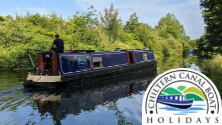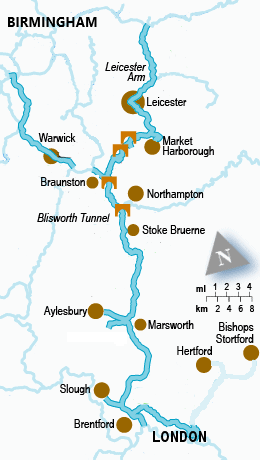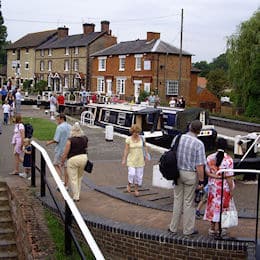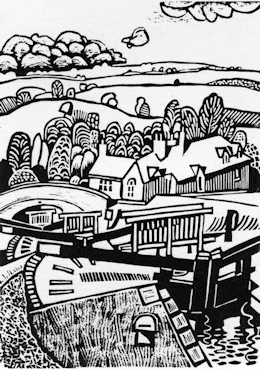Summer 2025 – Low water levels
Many canals and rivers are currently affected by low water levels caused by the current drought conditions in the UK. You can check a summary of which waterways are affected here and more detailed information on the CRT website .
The Grand Union Canal and the Regent’s Canal
The broad Grand Union Canal leaves the River Thames at Brentford and climbs over fifty locks up into the Chiltern hills. It descends then climbs again to a new summit in Birmingham, 137 miles and 166 locks. Boatmen used to claim to do it in five days but allow well over a week if you want to get any sleep!
The Grand Union Canal Main Line
The long steep climb out of London up and over the Chilterns goes through some beautiful scenery, especially through the partly 17th century Cassiobury Park.
Stoke Bruerne and Braunston are old canal towns, the Canal Museum and Boat Inn at Stoke Bruerne are worth a stop. Braunston Marina and dry dock are seeped in narrowboat history. The dry dock was built on the line of the original junction with the Oxford canal which was by-passed when the Oxford was straightened in 1805.
Just north of the Northampton Arm, which leads to the River Nene and gives access to the Lincolnshire Fens and Middle Levels, are Weedon Barracks, built here two hundred years ago because it was thought to be the place in England farthest from any possible coastal invasion!
There are long wide tunnels at Blisworth and Braunston. Wide boats must book their passage but narrowboats can pass inside the tunnel. There are other restrictions on wide boats.
ON THESE WATERWAYS…
The line into Birmingham goes through Royal Leamington Spa, fashionable in Victorian times and Warwick, famous for its medieval buildings and castle.
The 21 locks in the Hatton flight are a daunting sight for boaters who nicknamed the locks ‘the stairway to heaven’. The unusual geared paddle gear makes winding easy but slow! Hatton locks and the rest of the main line of the Grand Union Canal were part of a last gasp effort in the 1930s, backed by the government of the day, to modernize the canals so they could compete with road and rail. Bridges and Locks were widened and modern wharves created between Birmingham and London. It took two years and 1000 men to rebuild the 21 Hatton locks alone, using the new wonder material, concrete. Unfortunately wide barges never became common, mainly because it was all too late!
 Wyvern Shipping
Luxury Canalboat Holidays - Cruise the beautiful Grand Union Canal for short breaks & weekly hire. Families, pets & groups welcome. Prices are fully inclusive of fuel & damage waiver. Book Your Narrowboating Adventure Now!
Wyvern Shipping
Luxury Canalboat Holidays - Cruise the beautiful Grand Union Canal for short breaks & weekly hire. Families, pets & groups welcome. Prices are fully inclusive of fuel & damage waiver. Book Your Narrowboating Adventure Now!
The Leicester section
The broad Leicester Section branches north at Norton Junction, leaving the Grand Union main line to it’s steep climb into Birmingham. The Leicester section was intended to be a broad waterway, but it soon reaches the 7 narrow Watford Locks, lifting boats 16 metres (52’6”) to the Leicester Section summit level, 4 locks are in a staircase sharing top and bottom gates. The very restful summit level then meanders through wide rolling hills for over 20 miles before descending the Foxton staircases. The canal section before Leicester is very rural at times and has two tunnels at Crick and Husband’s Bosworth. It can be shallow and suffer from summer water shortages. A gentle decent through wide locks leads to a junction with the River Soar on the outskirts of Leicester, famous for its Roman ruins and the recently discovered burial place of King Richard III, killed in 1485 at the Battle of Bosworth.
 Chiltern Canal Boat Holidays
A family-run business providing short breaks and weekly narrowboat hire in the Chiltern Hills on the south Grand Union canal. Enjoy a slower pace of life, reconnect with nature and wake up to a stunning new view every day!
Dog-friendly. Beginners welcome.
Chiltern Canal Boat Holidays
A family-run business providing short breaks and weekly narrowboat hire in the Chiltern Hills on the south Grand Union canal. Enjoy a slower pace of life, reconnect with nature and wake up to a stunning new view every day!
Dog-friendly. Beginners welcome.
Foxton was the site of a steam powered Inclined Plane, hauling boats uphill in watertight tanks. Unlike the broad locks on the rest of the Leicester Section, the flights at either end of the summit level were built as narrow locks to cut costs. This prevented barges from the Trent and East coast reaching the broad waterways of the midlands and south. The Foxton Inclined Plane opened in 1900, replacing ten narrow locks and intended to be part of opening the waterway to broad barges. However money was never available to widen the Watford flight, so through barge passage was never possible. The narrow locks were reopened in 1908 and the plane became disused. There have since been numerous schemes to widen Watford locks but none have come to fruition.
For the last twenty or so miles the route is along or alongside the River Soar. The wide Soar winds through pleasant scenery to its junction with the River Trent. The Soar is subject to flooding and strong flows after heavy rains so must be navigated with care, especially when close to the lock weirs.
The Paddington Arm and Regents Canal
The broad Regent’s Canal links the Grand Union Paddington Arm through 2 tunnels and 12 locks to Limehouse Basin on the Thames. On the way from Little Venice it runs through Regents Park, past London Zoo, Camden Market and trendy Hoxton on its way to the Thames. Once busy with transshipped cargoes from sea going ships its towpaths are now lined by tourists, walkers and cyclists. Here, the London Canal Museum is well worth a visit.
Canal Rings
The Grand Union mainline from Braunston forms part of the Thames Ring, joining the River Thames at Brentford and the Oxford Canal from Oxford back to Braunston.
The Warwickshire Ring includes the Birmingham & Fazeley Canal, Coventry Canal and sections of the Grand Union and Oxford Canals.
The Leicester Section forms part of the Leicester Ring, with the Trent & Mersey Canal, Coventry Canal & North Oxford Canal.
The Regent’s Canal, GU Paddington Arm and Brentford section can form a short London Ring including the tidal Thames past the Houses of Parliament.
Maps & Guidebooks
You can by maps and guides covering the Grand Union Canal from our Online Shop.
All materials and images © Canal Junction Ltd. Dalton House, 35 Chester St, Wrexham LL13 8AH. No unauthorised reproduction.
About
| Terms
| Privacy |
Returns |
Sitemap
| Contact Us
Web Hosting & Development
With over 800 pages, this website uses cookies to record visitor behaviour using Google Analytics. More information on Privacy Page. Page last updated: 17/10/2025.












Back to Menu....
Canal Maps & Guides >>